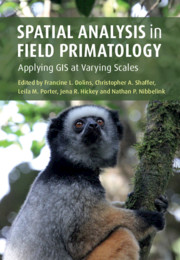Book contents
- Spatial Analysis in Field Primatology
- Spatial Analysis in Field Primatology
- Copyright page
- Dedication
- Contents
- Contributors
- Acknowledgments
- 1 Why Place Matters, and its Use in Primate Behavioral and Ecological Research
- Part I GPS for Primatologists
- Part II GIS Analysis in Fine-Scale Space
- Part III GIS Analysis in Broad-Scale Space
- Introduction
- 15 Modeling Niches and Mapping Distributions
- 16 Does Reduced Habitat Quality or Increased Hunter Access Explain Defaunation of Fragmented Forests?
- 17 Landscape Ecology of Deforestation Processes and Lemur Biogeography in Madagascar
- 18 Quantitative Methods for Primate Biogeography and Macroecology
- 19 GIS and GPS Techniques in an Ethnoprimatological Investigation of St Kitts Green Monkey (Chlorocebus sabaeus) Crop-Foraging Behavior
- 20 Conclusion
- Index
- Plate Section (PDF Only)
- References
20 - Conclusion
from Part III - GIS Analysis in Broad-Scale Space
Published online by Cambridge University Press: 29 January 2021
- Spatial Analysis in Field Primatology
- Spatial Analysis in Field Primatology
- Copyright page
- Dedication
- Contents
- Contributors
- Acknowledgments
- 1 Why Place Matters, and its Use in Primate Behavioral and Ecological Research
- Part I GPS for Primatologists
- Part II GIS Analysis in Fine-Scale Space
- Part III GIS Analysis in Broad-Scale Space
- Introduction
- 15 Modeling Niches and Mapping Distributions
- 16 Does Reduced Habitat Quality or Increased Hunter Access Explain Defaunation of Fragmented Forests?
- 17 Landscape Ecology of Deforestation Processes and Lemur Biogeography in Madagascar
- 18 Quantitative Methods for Primate Biogeography and Macroecology
- 19 GIS and GPS Techniques in an Ethnoprimatological Investigation of St Kitts Green Monkey (Chlorocebus sabaeus) Crop-Foraging Behavior
- 20 Conclusion
- Index
- Plate Section (PDF Only)
- References
Summary
The overarching theme of this volume is the application of spatial analysis technology and its potential for tackling major questions foundational to research conducted by field primatologists. In the series of chapters that comprise this volume, the goal of the editors and chapter authors was to provide a thorough reference for “best” as well as innovative practices in collecting and analyzing data using global positioning systems (GPS) and geographic information systems (GIS), including also the use of geo-tracking and remote telemetry apparatus via collars. The processes described are aimed at providing the most accurate measurements and interpretation of movement aligned with other forms of behavior. The authors have presented detailed mapping systems of multiple species and terrains that were distinct from one another and varied as examples for different types of field sites and their study requirements. Distinct ways in which mapping data might be collected, analyzed, and visualized, such that these examples provide models and insights for other researchers, were also discussed. These methods include studies that address theoretical and practical questions about life history strategies, individual and group movement, ecological problem solving, resource knowledge, foraging behavior, predator avoidance, social interactions and competition, and reproductive strategies. The application of GIS data provides insight into the interaction of biogeographical factors with behavior and also population-level genetics. Importantly, GPS data provide the foundation for detailed studies for conservation. A majority of primate species globally are on the brink of ecological disaster due to anthropogenic disturbances and pressures. Increasingly, scientists rely on the data provided by GPS technology to inform our attempts to stem habitat destruction and to protect parcels of habitat necessary to maintain viable primate populations and for the local human communities who are often equally at risk.
Information
- Type
- Chapter
- Information
- Spatial Analysis in Field PrimatologyApplying GIS at Varying Scales, pp. 428 - 433Publisher: Cambridge University PressPrint publication year: 2021
